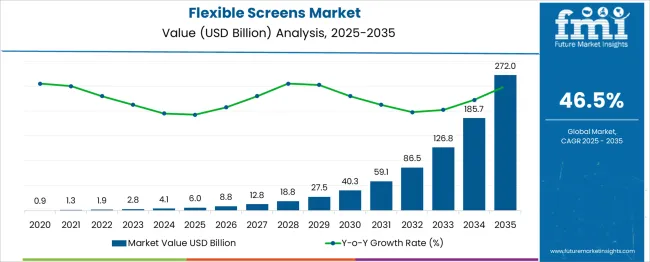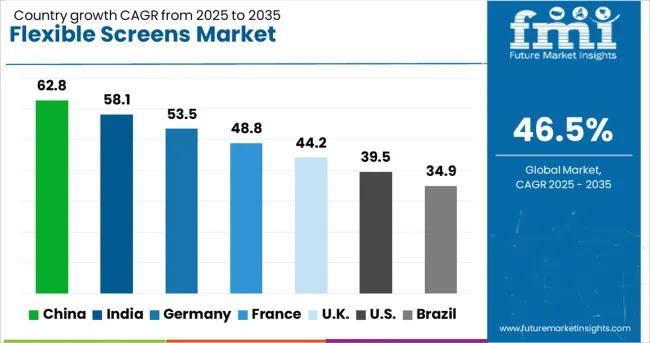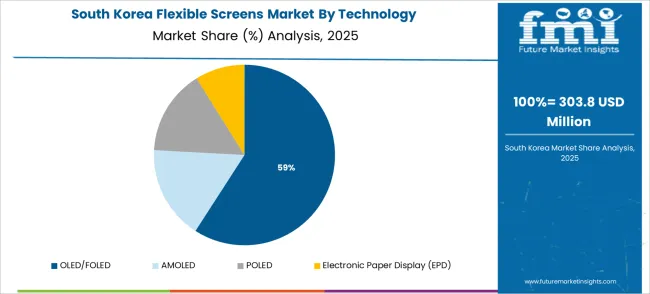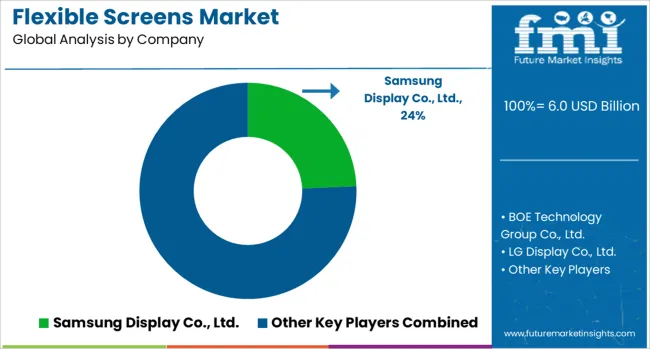The Flexible Screens Market is estimated to be valued at USD 6.0 billion in 2025 and is projected to reach USD 272.0 billion by 2035, registering a compound annual growth rate (CAGR) of 46.5% over the forecast period.

| Metric | Value |
|---|---|
| Flexible Screens Market Estimated Value in (2025 E) | USD 6.0 billion |
| Flexible Screens Market Forecast Value in (2035 F) | USD 272.0 billion |
| Forecast CAGR (2025 to 2035) | 46.5% |
Rapidly evolving screen technology has been witnessing frequent changes in technology. However, traditional technology is not being obsolete completely. During the years 2000-2010, TFT-LCD technology offered Flat, Slim, and Green screens for end-use products such as LCD TV and LCD laptops.
Between 2012 -2024 OLED technology offered Vivid, Light, and flexible screens for end-use products such as smartphones, tablets, OLED TVs, Unbreakable phones, Wearables, and foldable phones. OLED technology is further distributed to Glass-based OLEDs and Plastic-based OLEDs.
The evolution of these technologies into the flexible screens market has diluted the share of traditional technology to penetrate into advanced technology and the markets impacted by this are LED screens, flexible OLED screens, flexible Screens technology, flexible LED screens, flexible EPD screens, flexible glass screens, and flexible E-ink screens.
Upcoming OLCD and Electronic Paper Display technologies have high growth opportunities, which will significantly impact the flexible screen market during the forecast period.
The global market for flexible screens rising from the infancy stage of its lifecycle expanded at a three-digit CAGR of 142.1% over the last three years (2020-2024). The market growth is projected to saturate with the projected drop in their prices coupled with mass-level manufacturing resulting in benefits of economies of scale.
In 2024, nearly 1.4 Billion units of smartphones were shipped worldwide, of which flexible smartphones accounted for a meager 0.3% share. Flexible screens for smartphones also accounted for nearly the same proportion. In a decade’s time, it is highly likely that this proportion will swell to over 20%.
Currently, there are 11 brands of foldable and bendable smartphones in the market, of which six comes from Samsung’s flagship Galaxy series of smartphones. The other brand owners Huawei and Xiaomi have four and one brand respectively. In this competition of trio, the supply side is significantly heavy and stressed, as the smartphone manufacturers have been striving to procure a large volume of flexible screens.
Other applications of flexible screens including flexible screens for tablets, flexible screens for laptops, flexible screens for personal computers, flexible screens for smartwatches, flexible screens for smart wearables, flexible screens for televisions, and flexible screens for e-readers have either very low or no penetration in the consumer’s sphere owing to their lower added-utility as compared to smartphones.
Millennials have been observed to be the most active buyers of flexible screen-based devices owing to their growing income levels and increasing share of household expenditure on smart technology products. Nevertheless, buyers from other age groups will soon start purchasing them to make the demand more mainstream.
The global flexible screens market is predicted to surge ahead at a CAGR of 46.5% and record sales worth USD 272 Billion by the end of 2035. China, the global electronics manufacturing hub, will continue to be the largest procurer of flexible screens throughout the analysis period accounting for over USD 182 Billion absolute dollar opportunity in the coming 10-year epoch.
Manufacturers Vouch for Less Space Consuming Smartphones - Foldable Smartphones
Moor’s law is still relevant and its application can be observed with the continuous miniaturization of electronics. While electronic product manufacturers put their efforts into shrinking the dimension while retaining their utility, the consumers, on the other hand, feel that foldable, bendable, and rollable electronics as trendy which is uplifting their social status. With this trend, foldable smartphones will replace around 1/5th of all smartphones purchased by 2035.
The research will continue and Development will follow
Flexible screen manufacturers nowadays are closely working on commercializing OLCD display screens and it is projected that the mass production of OLCD will be initiated by the end of 2025. Flexible panels, including flexible passive transparent TSPs, flexible active backplanes, and flexible light sources, have been studied at the UNIST research center in order to bring flexible devices to reality.
In addition, testing of nano-scale flexible panels was carried out to assess the performance of similar individual materials to those found in flexible panels. A readout IC for the display panel was also investigated in order to achieve consistent curved flexible panel performance.
Finally, the flexible device's ergonomics were investigated in order to determine its impact on human users. This flow of research solely dictates the growing appetite of end-use sectors for flexible screens which are pushing the development.
Low-cost flexible displays poised for growth include electrophoretic displays, electrochromic displays, and electroluminescent displays. Some of the organizations continuing the research and development of flexible displays are Flexible Display Roll to Roll Research Center (FDRC), Flexible Electronics and Display Center, Arizona State University, National Centre for Flexible Electronics, IIT Kanpur, and Ulsan National Institute of Science and Technology.
Many technologies have been developed to create flexible displays. Electrophoretic displays (EPD) and OLEDs are most advantageous and contribute to the exponential growth of flexible screen penetration. EPDs were first used as an electronic paper display, thereby creating a flexible material laminated on a rigid thin-film transistor (TFT) active matrix.
Liquid crystal displays (LCD) can be used in flexible form factors theoretically, however, the trend in flexibles is increased deployment of OLEDs, which do not require a backlight as they are self-luminous, and have reduced thickness and faster response times while improving color and contrast.
OLED technology represents a new era of low-energy, transparent and flexible displays and lighting products that are already in production due to their low cost, better applicability, and ease of manufacturing.
From Smartphones to smart clothing - Onus Goes to Flexible Screens
Wearables have gained significant attention these days, with new substrates, low power requirements, power scavenging, durability, and novel connectivity. Korean researchers claim to have invented meta-display technology, which could become a prominent factor in increasing the demand for next-gen wearables.
Most stretchable materials (rubber, cloth, or anything else having some elasticity) tend to shrink in one direction when stretched in the other direction. While usually this is not an issue but can be an issue in some applications. However, no one wants to sew a touchscreen display on the sleeves of jackets and move the arm to distort the image on the screen.
Designed to overcome this fundamental difficulty with stretchable displays, metamaterials have been brought into the picture, which are sophisticated materials that are often composed of small elements arranged in repeating patterns that exhibit unique behavior which is not found in natural materials. Metamaterials could thus be the key to the sustained growth of the flexible display market in the coming years.
The idea of intelligent apparel as a category of clothing that has dynamic functions, further to the conventional properties of clothing, has been introduced. The intelligent feature of the clothing is obtained by utilizing either a specifically developed fabric or by integrating a digital device into conventional fabric.
Thus, a sweater that adjusts color under the effect of heat should be regarded as smart clothing, as should a bracelet that monitors the heart rate of an athlete even as he/she is exercising.
Accordingly, three categories for these smart clothing are envisaged as follows:
Smart clothing can be used in manual or automatic modes. The wearer can act on added intelligent functions while automatic function cloths react autonomously to external parameters like light, temperature, and humidity.
The growing prevalence of such types of applications in the apparel industry is the key factor that will generate demand for flexible displays in the future. This is expected to augment the demand for flexible screens in the wearables category.

The World’s Factory to Retain its Dominance for Flexible Screens Consumption
China accounted for over 97% of the global flexible screens market in 2024, representing the first choice of global small electronics product manufacturers.
The mix of lower wages, availability of technical workforce, fertile business ecosystem, lower compliance, business-friendly taxes and duties, and depressed national currency makes it a lucrative production hotspot for several products, especially electronics. With these statistics, it will be no wonder to expect China as a market with a USD 6 Billion absolute dollar opportunity between 2025 and 2035.

Flexible Smartphones to Rollable TVs - South Korea revving up to Become Hotspot for Next Electronics
In 2024, South Korea was the second-largest flexible screen consumer after China, with a market value of USD 51 Million. Currently, it is the only rollable television manufacturer worldwide. Being the headquarters of the electronics giant Samsung, South Korea generates strong demand for flexible screens for the manufacturing of foldable smartphones.
It is highly likely, that South Korea will become a USD 272 Billion flexible screens market forecasted by the end of 2035.
Most flexible electronics manufactured currently use flexible screens of display size 6’’ - 20’’
Smartphones and tablets and laptops are the only electronics using flexible screens currently. Considering their size, the requirement for flexible screens with panel sizes 6’’- 20’’ accounts for a revenue share of over 99%.
Other panel sizes which include up to 6’’ and above 20’’ are highly unlikely to gain more than 1% share throughout the analysis period, as they are used to fulfill the demand for flexible screens for smartwatches and wearables, demand for flexible screens for televisions, and demand for flexible screens for e-readers.
While TVs presently are made to order and have a significantly high price tag, e-readers are yet to be commercialized. With the miniaturization of smartphones, most of the features of wearables will be available with smartphones.

At present, flexible screen manufacturers are largely aiming at setting up manufacturing facilities, winning orders, and showcasing technology at exhibitions.
The key companies operating in the flexible screen market include Samsung Display Co. Ltd., BOE Technology Group Co. Ltd., LG Display Co. Ltd., Visionox Technology, Inc., AU Optronics Corp., Tianma Microelectronics Co. Ltd., Shenzhen Royole Technologies Co. Ltd., E Ink Holdings Inc., HannStar Display Corporation, ever display Optronics (Shanghai) Co. Ltd., Iljin Display Co. Ltd., Shenzhen RADIANT Technology Co. Ltd., and Osel Technology Pvt. Ltd.
Some of the recent developments by key providers of flexible screens are as follows:
Similarly, recent developments related to companies manufacturing Flexible Screens have been tracked by the team at Future Market Insights, which is available in the full report.
| Attribute | Details |
|---|---|
| Forecast Period | 2025 to 2035 |
| Historical Data Available for | 2020 to 2024 |
| Market Analysis | USD Million for Value |
| Key Countries Covered | China, South Korea, Taiwan, and India |
| Key Market Segments Covered | Functionality, Technology, Panel Size, and Application |
| Key Companies Profiled | Samsung Display Co. Ltd.; BOE Technology Group Co. Ltd.; LG Display Co. Ltd.; Visionox Technology, Inc.; AU Optronics Corp.; Tianma Microelectronics Co. Ltd.; Shenzhen Royole Technologies Co. Ltd.; E Ink Holdings Inc.; HannStar Display Corporation; Everdisplay Optronics (Shanghai) Co. Ltd.; Iljin Display Co. Ltd.; Shenzhen RADIANT Technology Co. Ltd.; Osel Technology Pvt. Ltd. |
| Report Coverage | Market Forecast, Competition Intelligence, Drivers, Restraints, Opportunities and Threats Analysis, Market Dynamics and Challenges, and Strategic Growth Initiatives |
| Customization & Pricing | Available upon Request |
The global flexible screens market is estimated to be valued at USD 6.0 billion in 2025.
The market size for the flexible screens market is projected to reach USD 272.0 billion by 2035.
The flexible screens market is expected to grow at a 46.5% CAGR between 2025 and 2035.
The key product types in flexible screens market are bendable and foldable display and rollable display.
In terms of technology, oled/foled segment to command 56.9% share in the flexible screens market in 2025.






Full Research Suite comprises of:
Market outlook & trends analysis
Interviews & case studies
Strategic recommendations
Vendor profiles & capabilities analysis
5-year forecasts
8 regions and 60+ country-level data splits
Market segment data splits
12 months of continuous data updates
DELIVERED AS:
PDF EXCEL ONLINE
Flexible Packaging Paper Market Size and Share Forecast Outlook 2025 to 2035
Flexible Plastic Pouch Market Size and Share Forecast Outlook 2025 to 2035
Flexible Plastic Packaging Market Size and Share Forecast Outlook 2025 to 2035
Flexible Rubber Sheets Market Size and Share Forecast Outlook 2025 to 2035
Flexible Printed Circuit Boards Market Size and Share Forecast Outlook 2025 to 2035
Flexible Packaging Machinery Market Size and Share Forecast Outlook 2025 to 2035
Flexible Electronic Market Size and Share Forecast Outlook 2025 to 2035
Flexible Foam Market Size and Share Forecast Outlook 2025 to 2035
Flexible Plastic Packaging Industry Analysis in United States Size and Share Forecast Outlook 2025 to 2035
Flexible Protective Packaging Market Size and Share Forecast Outlook 2025 to 2035
Flexible AC Current Transmission System Market Size and Share Forecast Outlook 2025 to 2035
Flexible End-Load Cartoner Market Size and Share Forecast Outlook 2025 to 2035
Flexible Packaging Market Size and Share Forecast Outlook 2025 to 2035
Flexible Metallic Conduit Market Size and Share Forecast Outlook 2025 to 2035
Flexible Electrical Conduit Market Size and Share Forecast Outlook 2025 to 2035
Flexible Display Market Size and Share Forecast Outlook 2025 to 2035
Flexible Substrate Market Size and Share Forecast Outlook 2025 to 2035
Flexible Paper Battery Market Size and Share Forecast Outlook 2025 to 2035
Flexible Metallic Tubing Market Size and Share Forecast Outlook 2025 to 2035
Flexible Barrier Films for Electronics Market Size and Share Forecast Outlook 2025 to 2035

Thank you!
You will receive an email from our Business Development Manager. Please be sure to check your SPAM/JUNK folder too.
Chat With
MaRIA